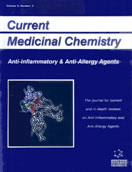Abstract
Nuclear medicine offers ideal techniques to visualize inflammatory processes using noninvasive methods of whole-body scanning, enabling the determination of both the localization and the number of inflammatory foci. In nuclear medicine, a radiolabeled compound is injected (mostly) intravenously and accumulates in the inflammatory lesion due to the locally changed physiological condition. These changes are enhanced blood flow, enhanced vascular permeability and enhanced influx of leukocytes. Radiopharmaceuticals can be primarily divided into two classes: those accumulating in the inflammatory lesion based on non-specific processes and those accumulating in connection to leukocytes. Nonspecific tracers like 67Ga-citrate, radiolabeled non-specific immunoglobulins and radiolabeled liposomes are discussed in detail. Studies using specific tracers mainly focus on radiolabeling leukocytes, either directly or indirectly. Direct labeling of isolated leukocytes and reinjecting them is considered the ”gold standard“ nuclear medicine technique for imaging inflammation. Labeling leukocytes in vivo (the indirect approach) can be achieved by the use of radiolabeled antibodies or by compounds binding to leukocyte receptors with high affinity. At least three anti-granulocyte antibodies have been tested for infection imaging: anti-NCA-95 IgG (BW250 / 183), anti-NCA-90 Fab (Immu-MN3, leukoscan®: anti-CD66), and anti-SSEA-1 IgM (LeuTech®: anti-CD15). In addition, a w ide var iety of pe ptide s binding to le ukocyte re ceptors ha s be en inve stiga ted, e.g. chemota ctic pe ptide formyl- Me t-L eu-Phe, cytokines such as inte rleukin-1, inte rleukin-2, inte rleukin-8 and pla te let f actor 4 (deriva tives) a nd complement f ac tor s suc h as C5a. Furthermore, positron emission tomography with 18Ffluorodeoxyglucose takes advantage of the enhanced glucose requirements of leukocytes and macrophages in inflammatory foci. A totally different approach is to target directly micro-organisms, without intervention of leukocytes. This strategy is adopted in radiopharmaceuticals such as Infecton and antimicrobial peptides. The discussed radiopharmaceuticals enable accurate diagnosis of the inflammatory condition and with these agents the effectiveness of anti-inflammatory therapies can be monitored.
Keywords: Scintigraphic Imaging, Inflammatory Processes, liposomes, cytokines, interleukin-1 il-1, interleukin-8 il-8, platelet factor 4 pf-4, intereukin-2 il-2
 8
8

